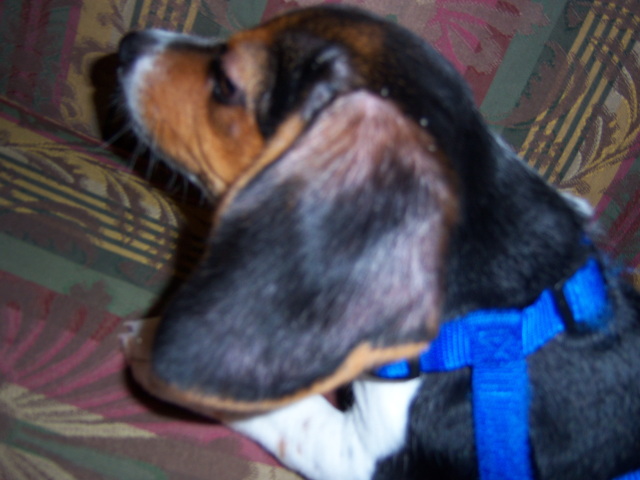QuestionHello, I have a 3 year old Bluetick/Beagle. He has developed some serious itching over the past few months. The vet has tried some prednisone, sufur shampoos and some benadryl here and there. Added fish oil to diet for a bit, and swithed food over to IAMS. My Freddie itches all over, he scatches his back on the kitchen chair and moans. He scratches until its raw in places. I can t seem to help him out, I cant afford to let the vet guess anymore. His skin that is raw has little pimple like bumps all over and is scaley. His coat is still shiny and smooth. ?? Do you have any ideas ?
AnswerDear Matt,
Unfortunately I DO have a very good idea of what is going on. It sounds like your poor Freddie has Sarcoptic Mange. I am going to paste in some info for you but you need to tell the vet you want him to prescribe Ivermectin or if he will not then go to a canine dermatologist or another vet. This is a very difficult condition, seldom shows up on skin scrapings and tough to treat.
I had the unfortunate experience about 6 months ago of my 15 y/o female beagle contracting this at a dog park, She in agony and the regular vet couldn't figure it out so I took her to a canine dermatologist.I also then contracted it and after 3 human dermatologist's treatments failed, I went to UCLA to get the proper treatment which was exactly the same as the dogs, Ivermectin! No amount of Prednisone, shampoo, benadryl etc helped either one of us. You will read conflicting info on the internet saying that it does not transfer to humans (zoonotic) but it did, and the UCLA derm verified that it can so be very careful. Your dog needs treatment ASAP or secondary infections set in and then you have to treat those as well, as did we. Here is some reliable information. Please let me know how things turn out and if this is found to be the case with Freddie. Good Luck!
*****************************************************************
"Sarcoptic mange (also known as scabies) is a highly contagious parasitic disease caused by a microscopic mite called Sarcoptes scabiei that affects animals and people. These mites invade the skin of healthy dogs and puppies and create a variety of skin problems. Humans exposed to infested dogs commonly are affected.
The hallmark of the disease is intense pruritus that does not respond to symptomatic treatment; the dog scratches and chews at himself. There may also be papules (small red bumps) located on the margins of the ears, elbows, hocks (ankles), chest and abdomen. These lesions may become generalized.
Other symptoms may include patchy hair loss, and crusty sores.
Symptoms are thought to be the result of a severe allergic reaction to the mite. Just a few mites can cause severe generalized pruritus (itchiness), which sometimes persists after therapy due to the allergic component of this disease. The incubation period (time until clinical symptoms become apparent) can be as long as 3 weeks after exposure.
If left untreated, chronic skin lesions develop including increased pigmentation, thickening and wrinkling of the skin, ulcerations and draining tracts. Secondary bacterial infections are common due to self-trauma.
The best treatment consists of the administration of the anti-parasitic drug ivermectin once every 2 weeks for 3 treatments.
Revolution, a topical product applied monthly for flea control and heartworm prevention, also is a safe and effective treatment for sarcoptic mange. Rewvolution is the same as Ivermectin. It can also be administered by injection.Treatment with antibiotics may be necessary if your dog has developed a secondary bacterial infection.
The primary lesion is the pruritic erythematous papule, which is an itchy, red, raised skin bump. Later, these papules become associated with thick yellow-gray scale/crusts, especially on the ear. Sarcoptic mange has predilection for areas with sparse hair
All extremely pruritic dogs with typical clinical symptoms should be treated. Dogs with non-seasonal pruritus that is poorly responsive to treatment with cortisone-like drugs (glucocorticoids) should be treated for sarcoptic mange to rule out this possibility.In most dogs with sarcoptic mange, pruritus is reduced by at least 50 percent 7 to 10 days after the first treatment and pruritus gradually disappears within 4 weeks
All animals in the household should be treated. Various treatments may be used to eradicate sarcoptic mange mite infestation
Prevention consists of avoiding contact with infected animals. Mites do not survive very long in the environment, and direct contact is necessary to become infected.
Therapy must be carried out over the entire life cycle of the mite (for 3 weeks). With appropriate therapy, pruritus and skin lesions should resolve completely.

 11 month old female beagle suddenly eliminating in the house?
Question
ruby
Hi I have an 11 month old female beagle
11 month old female beagle suddenly eliminating in the house?
Question
ruby
Hi I have an 11 month old female beagle
 beagle house training
Question
Panda with my chocolat
I apologize in advance
beagle house training
Question
Panda with my chocolat
I apologize in advance
 what type of beagles is he , like is he mix with what
Question
beagle
Im getting this dog, well hopefu
what type of beagles is he , like is he mix with what
Question
beagle
Im getting this dog, well hopefu
 My Beagles ears?
QuestionOne of Hunters ears.
QUESTION: Hi. Hunte
My Beagles ears?
QuestionOne of Hunters ears.
QUESTION: Hi. Hunte
 beagle puppy
QuestionQUESTION: dear, i just have a beagle pup, he is
beagle puppy
QuestionQUESTION: dear, i just have a beagle pup, he is